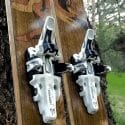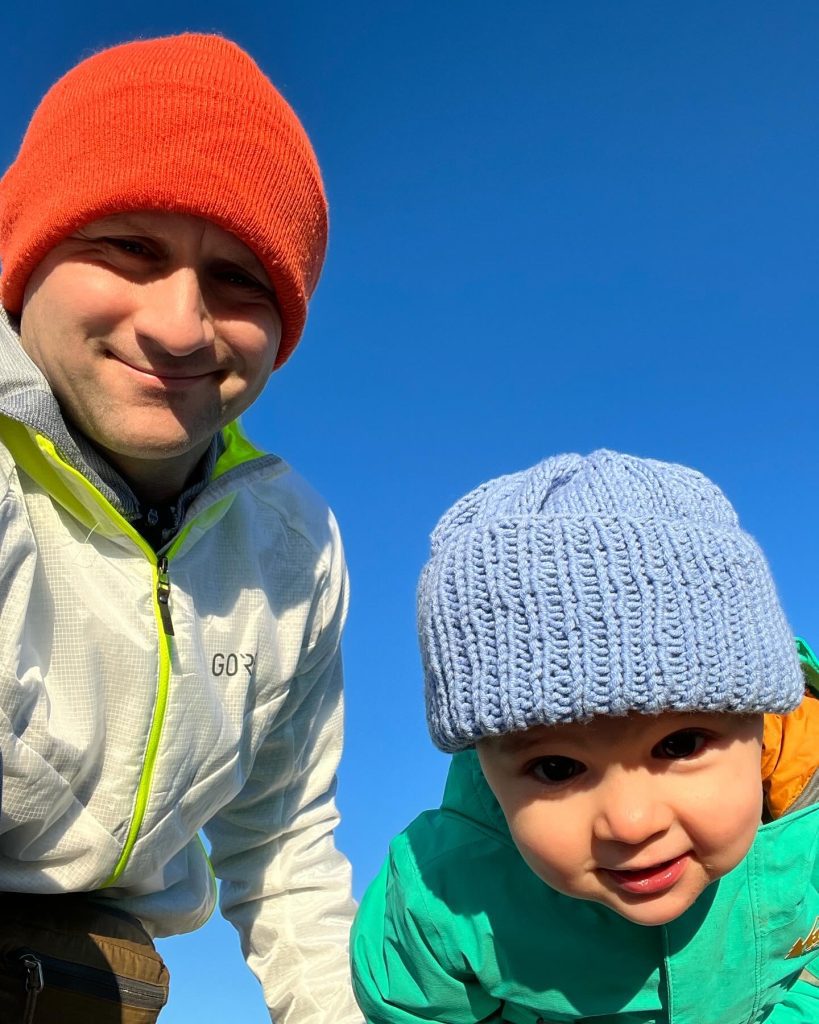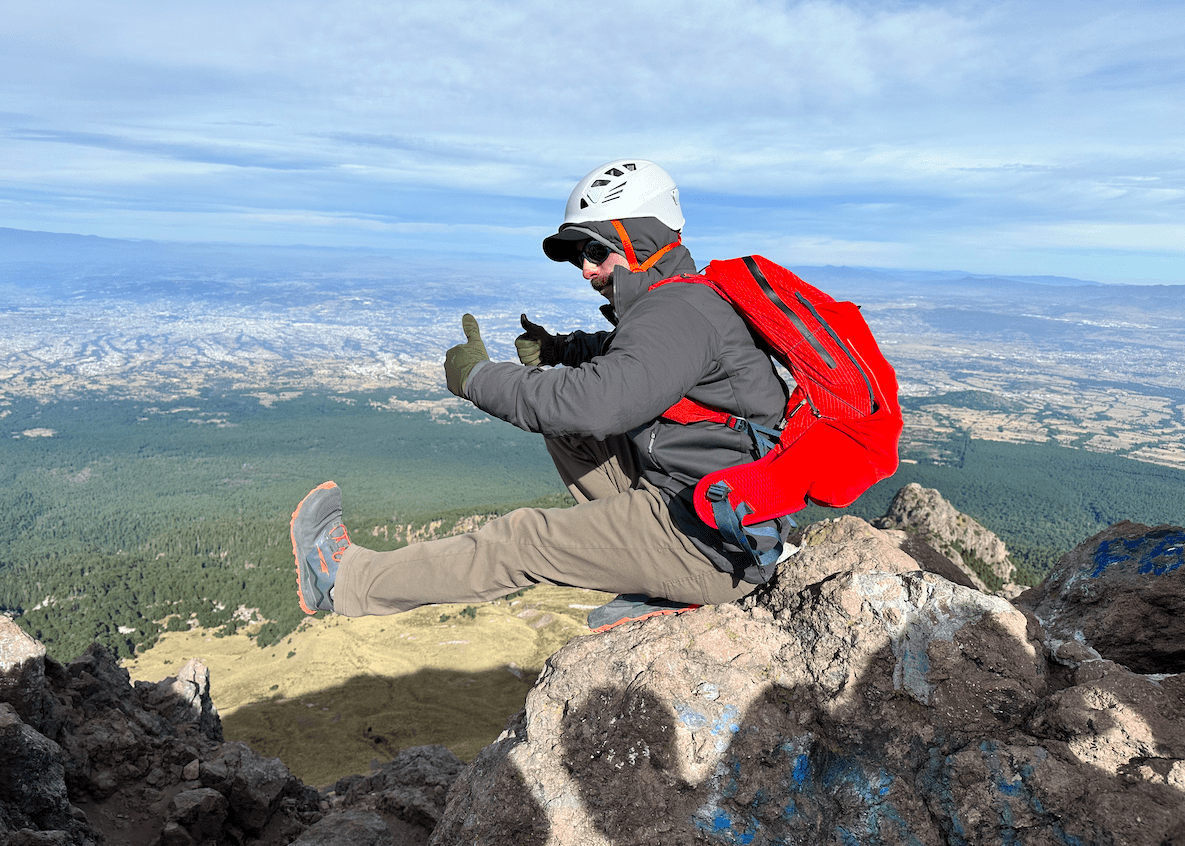When taking a trip into the backcountry on skis, you need some specialized equipment. Normal ski boots and bindings are designed to unify your foot and the ski. That’s fine and dandy when you’re on your way down – which, we’ll admit, is definitely part of backcountry skiing. How else would you get back to your car? It also happens to be sort of fun.
But, unifying your foot and ski on the way up? That makes walking hard. Think about trying to walk through the snow with a pair of six-foot-long feet that you can’t bend. Doesn’t that just sound awkward? The solution is alpine touring gear – boots that allow your ankles to flex and bindings that release your heel to give you a natural stride.
Update:
Fritschi updated the Vipec for this season. They eliminated our gripe about the toe guides by changing the shape, lengthened the lever on the toe piece a bit to make exit easier, and, most important of all, got TUV certification for the Vipec. The prior one probably could have been certified, but Fritschi didn’t submit them.
Please notice that there are now two different versions of the Vipec available for sale, above. The old version is on sale and works just fine. The new version, designated TUV above, is not on sale yet. It has the latest updates.
You really have two choices when it comes to alpine touring bindings: tech bindings, which use metal pins heel and toe to retain your boot; and frame bindings, which look like alpine bindings that pivot on a platform. Conventional wisdom says that tech bindings are better on the way up and frame bindings better on the way down. The reason involves elasticity and forward pressure and other wonderful things. The point is, until recently, tech bindings didn’t ski so well. That all changed over the past few years with the release of a new type of tech binding that incorporates the features of alpine bindings. Our favorite binding right now? The Fritschi Vipec.
During the on snow demo at SIA this year, we tried a bunch of the new crop of tech bindings. Members of this illustrious group? The Vipec, G3’s ION, Dynafit’s Beast, and Marker’s Kingpin (sort of). After demoing, the Vipec landed at the top of the pile. We included some comments on the Vipec in our Black Diamond Boundary 115 Ski review video:
What makes the Vipec special? Well, for starters, it’s one of two tech bindings with a true lateral toe release (the Beast 16 is the other). It’s also the only tech binding designed to transition from ski mode to walk mode and back to ski mode without removing your boot from the bindings. The Beast is supposed to do that as well, but, in practice, it’s not easy. Another bonus – no need to retrofit a different heel fitting onto your boot to use the Vipec. The Beast requires that.

Fritschi differentiates the Vipec further by including an adjustable toe pin on the right wing. While Dynafit tech fittings are standardized, some other boot brands produce their own fittings that may be off-width by a millimeter or seven. That’s not a big deal when your binding doesn’t have a lateral toe release. But, when it does, the interface between pin and fitting can affect release consistency, so Fritschi makes it adjustable. The first generation toe pin had a tendency to self-adjust its way right out of the binding. Fritschi redesigned it to make it more secure, switching it to the right wing from the left so the touring motion acts to tighten the pin instead of loosening it. They also added a cotter wire to prevent any rotation.
We’re fond of the look of the Vipec, if not the name. Entirely subjective, we know, but Vipec? Really? Someone let the Swiss engineers think that one up. They’re wizards when it comes to binding design but should leave the names to marketing. The binding is constructed mostly of a white polymer. It looks good with everything and nothing at the same time. If you’re into personalization, Black Diamond offers color kits for about $30 that lets you change the look of the toe piece and heel piece by replacing the black plastic caps. They’re available in pink, red, yellow, blue, and green.
Our Vipecs are mounted on a pair of custom Ski Logik skis with a 115mm waist. We selected the 120mm brakes (95mm and 108mm brakes are also available), but still got interference with the sidewalls to the point where the brakes did not deploy unless coaxed with a ski pole or swift kick. A few minutes with a file remedied this problem.
On the way down the hill, The Vipec feels almost like an alpine binding, and that’s saying a lot. Normal tech bindings feel harsh. They transmit all of the chatter of the ski directly into your boot because they have no elasticity or damping. The Vipec allows lateral movement in the toe which absorbs that vibration. Your legs will thank you at the end of the day. You also get forward pressure from the heel-piece, which ensures that release values stay consistent as the ski flexes.

On the way up the hill, the Vipec offers a smooth touring motion like any tech binding. As usual, you pull the lever on the front of the binding up to engage touring mode. Where the Vipec stands out is that the lever doesn’t lock your toe in the binding like most other tech bindings. Instead, it locks out the lateral elasticity while leaving the release mechanism alone. In other words, your foot won’t slide side to side in the binding, but if you get caught in an avalanche, your ski will release instead of hitting you in the face. For steeper climbs, the Vipec offers three levels of heel lift – flat, 9°, and 13°. The heel risers are easy to engage and disengage with a pole handle.
There are some rumors going around that the plastic in the heel risers can break. In fact, we’ve spoken to a few people that have experienced it. Not something to worry about, in our opinion. We’ve been stomping on them with 220+ lbs all season and they’ve held up just fine. We did have an issue with the release values set at the shop that mounted them. For some reason, both the heel and toe piece were set to an RV of 5. That’s laughably insufficient for anyone over 200 lbs and had us popping out of the bindings while skinning up in tour mode. A quick trip to screwdriver and to up the RVs to about 9 and we haven’t had an issue since. The Vipecs release when they’re supposed to and stay put when they aren’t.

Actual gripes? Only one: the toe guides, meant to assist you in lining up the toe pins with the fittings on your boot, either don’t work or are much smarter than we are. We subscribe to the 10% rule – you must always been 10% smarter than the gizmo you’re trying to operate to get it to work. Which is to say that we’re dumber than a pair of ski bindings. Darn. We’d love it if the Vipec’s toe guides were a bit higher.
Overall, we recommend the Vipecs over the rest of the recent crop of tech bindings. We don’t like that Marker stuck with their underfoot lever to transition to tour mode. That’s amateur hour. We prefer the Vipec’s lateral toe release to the G3’s heel-focused release mechanism, although the ION’s toe piece is otherwise fabulous. If we had nothing but endless laps in a powder wonderland, the ION could potentially take over the top spot on our favorites list. Dynafit’s Beast requires retrofitting a new heel fitting onto your boot and only offers lateral toe release in the $1000 Beast 16 version. The (relatively) affordable Beast 14, which is still $200 more expensive than the Vipec, comes with Dynafit’s Radical 2.0 toe. There’s some rotation in the toe to assist release, but it doesn’t release laterally.
Here’s the thing: we like the Vipecs so much, we actually paid for the pair we’ve been using for the season. If you decide to pick up a pair, please use our Gear Search tool to find the lowest price from over 150 retailers.
Once you’re a proud Vipec owner, Fritschi recommends you store your bindings in the “Ski” position to leave the release spring uncompressed during storage.
See also:







Leave a Reply